Hi! As promised, here is the hunting breastplate tutorial. It is part of my tack set tutorials group, and I am doing it on Totilas (him being the model for my recent tutorials). You can use ribbon and leather lace as an alternative for what I'm using. Anyway...
You will need:
Leather strips (cut long, thin ones which are as equal as you can make them)
Jump rings (6mm is the best for all scales)
Sticky backed felt (white looks best) or normal felt
Lobster clasps
A model horse of any scale (I'm using Traditional scale)
A glue gun or some reliable glue
Let's get started!
1. Have your leather strips ready and waiting so you can do everything easily. Thread a jump ring through one of your leather strips and glue it. Trim away excess glue and leather from the sides of the jump ring if needed.
2. Measure around the neck of the horse, slightly above the withers, and give a little slack (a bit more than the width of the jump ring) for gluing.
3. Glue the leather strip around the same jump ring so you have a complete neck strap.
 |
| This is what the finished neck strap should look like |
4. Glue a leather strip to the jump ring, but make sure it faces downwards. This is the strap that goes between the front legs and loops around the girth.
5. Make a simple loop at the end of the strap in step 4 and glue it. This should be wide enough for your girth.
6. Make the martingale straps - the reins will go through the jump rings. Glue a jump ring to a strip of leather and glue it on to the ring. Repeat on the other side. If you don't have enough room, cut the strap thin where you are gluing it but make sure it is the full thickness at the part that you can see.
7. Glue a very short piece of leather on your neck strap, ideally around the height where your saddle's D rings are (where the lobster clasps attach to). Repeat on the other side and make sure they are equal.
8. Glue jump rings to the short leather pieces.
9. Open the jump ring and slip on your lobster clasp. If you like you can do it before you glue it on. I find doing it after better as then the lobster clasp doesn't swing about and get in your way. It's your preference!
10. Glue your felt or sticky backed felt to the jump ring. This prevents the jump ring scratching your model, and it also looks cool as that is what real breastplates and hunting breastplates have!
11. This is an optional step but it looks quite cool, especially with horses that look spooky or out of control. Glue a little extra neck strap, but just the top half. Have a look at real breastplates and you'll notice they have them too!
12. And you are done! Make sure your saddle has D rings first so you can clip the lobster clasps on to those.
Thanks for looking at my tutorial! Have a look tomorrow around this time (4ish) and see what I've put up!
Bye!




















































